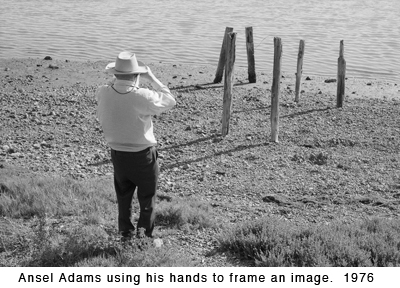One of the most challenging things in creating a strong image in photography is the need to find order in chaos. In the urban jungle there are wires, poles, signs, traffic and the like. In the natural world there are rocks, bushes, branches and landforms all contributing to visual mayhem.
In an earlier writing I discussed the fact that it is point of view that creates structure in a photograph, and that one’s choice of lens is after the fact and serves only to effect the most agreeable cropping. But making that choice of lens is often a lot easier said than done. Looking through a viewfinder or at the upside-down image on a groundglass, it is easy to become somewhat fixated on the subject itself, rather than the elements of the composition.
Regular use of a cut-out viewing card can do wonders for tightening up your seeing and compositional strengths. Ansel Adams was a great proponent of using a viewing card and routinely included them in workshop student packets. Completely low-tech, the “tool” is simply a card with a hole cut out in the same shape as your film / image format.
When you are standing on the spot where you plan to make your photograph, instead of looking through your camera to explore the structure of the image, hold the card up to your scene, moving it subtly left, right, up down – AND nearer to and farther away from your eye. You have what amounts to a zoom lens with infinite focal lengths from at-your-nose to full-arm’s-length away! If the card is white, the scene before you can even look like it is already mounted ready for display! Neat?
Wait! There’s more! If the hole in the card is the same size as the format you are using, you can even tell pretty nearly just what focal length to use. If you are using a 4×5 camera and the card’s hole is about 4×5 inches, the distance away from your eye is the same as the appropriate focal length! If the card is about eight inches from your eye for the right framing, that would indicate a 210mm lens (eight inches is 203mm). If you are using a 6×7 camera and have a 6x7cm hole in your card, when the card is about six inches from your eye, that would suggest a 150mm lens!
When I’m working with my 8×10 camera, because of its weight and bulk, I don’t usually haul it around with me while I am exploring a subject. I often leave it in the truck, or parked peacefully under a tree, and instead go for a walk with my cut-out card. Once I have found my “spot” I’ll mark it with a rock or something and hop back to get the camera, already knowing pretty well what lens I am going to start with. Now, you can imagine that a card with an 8×10 hole in it would be a bit awkward – and it would be – but instead I just use my 4×5 card and double the indicated focal length. Thus, if the card is nine inches from my eye, that would indicate the 450mm lens.
In truth, I don’t always have a card with me, but my hands are large enough to form an approximately 4×5 frame, and that works just fine.


